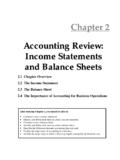Transcription of WHICH ACCOUNTING METHODS FOR SMALL …
1 WHICH ACCOUNTING METHODS FOR SMALL construction CONTRACTORS ARE ALLOWED FOR TAX PURPOSES? WHICH IS BEST? A DECISION HEURISTIC HELPS CHOOSE JEFFREY N. BARNES School of Business Southern Utah University 357 West Center Cedar City, Utah 84720 (435) 586-5406 KATHERINE BLACK School of Business Southern Utah University 357 West Center Cedar City, Utah 84720 (435) 586-7773 2 WHICH ACCOUNTING METHODS FOR SMALL construction CONTRACTORS ARE ALLOWED FOR TAX PURPOSES? WHICH IS BEST? A DECISION HEURISTIC HELPS CHOOSE ABSTRACT Many tax preparers still have difficulty determining and properly communicating the allowable tax ACCOUNTING METHODS and bookkeeping procedures needed for SMALL construction contractors, especially those having partially-completed contracts at year-end. For many SMALL construction contractors the Internal Revenue Code is confusing and even court opinions give mixed signals as to WHICH ACCOUNTING method is permissible.
2 This paper provides a discussion on the allowable METHODS of tax ACCOUNTING and provides a decision heuristic to simplify the choice of allowable METHODS . The paper also offers suggestions about bookkeeping procedures. 3 WHICH ACCOUNTING METHODS FOR SMALL construction CONTRACTORS ARE ALLOWED FOR TAX PURPOSES? WHICH IS BEST? A DECISION HEURISTIC HELPS CHOOSE INTRODUCTION For many SMALL construction contractors the Internal Revenue Code is confusing with regard to WHICH ACCOUNTING method they are to use. Even court opinions give mixed signals as to WHICH ACCOUNTING method is permissible (Ansley-Sheppard-Burgess Co. v. Commissioner, 104 TC 367 and Thompson Electric, Inc. v. Commissioner TC Memo 1995-292). Many people tax preparers, consultants, company controllers still have difficulty determining and properly communicating the allowable tax ACCOUNTING METHODS and bookkeeping procedures needed for SMALL construction contractors.
3 This paper is written to clarify the tax ACCOUNTING METHODS available to SMALL construction contractors those defined as having less than $10,000,000 of average annual gross receipts over the past three years with significant inventories as construction -in-progress or work-in-process (WIP) at year-end. Also, this paper will discuss what should be presented on the balance sheet at year-end under the varying tax ACCOUNTING METHODS chosen by the SMALL contractor. Further, this paper will recommend some bookkeeping procedures or strategies that are helpful for the tax preparer, including the information that should be properly presented on the tax return and the taxpayer s balance sheet. It will also facilitate the appropriate choice of an ACCOUNTING method, by the use of a decision heuristic. Method of ACCOUNTING the Basic Rules 446(c) generally allows a taxpayer to select the method of ACCOUNTING it will use to compute its taxable income.
4 446(b) provides that the selected method must clearly reflect income. In addition, Reg. (c)(2)(i) requires that a taxpayer use an accrual method of ACCOUNTING with regard to purchases and sales of merchandise whenever 471 requires the taxpayer to account for inventories, unless otherwise authorized by the Commissioner under (c)(2)(ii). Choosing a method of ACCOUNTING that clearly reflects income sounds simple enough but may pose many not-so-simple questions: 1. If construction contractors have significant partially-completed contracts at year-end, can they expense current-year costs for partially-completed contract costs? 2. If a construction contractor takes partial payments for completion of certain phases of construction , can those cash payments be deferred until the contract is fully completed? 4 3.
5 If a contractor arranges cash payments by a trust agreement only upon completion of the project and the contractor is the trustee of the trust, can revenue recognition be deferred until the project is completed? 4. If the contractor constructs only residential homes ( townhome complex) rather than home commercial construction contracts, are there special tax METHODS of ACCOUNTING needing to be followed? 5. Can a construction contractor with significant inventories at year-end be a cash-basis taxpayer for tax purposes? 6. Are there special tax ACCOUNTING METHODS allowed for construction contractors that assist in deferring taxable income recognition? Method Used for Taxes must Be Method Used on the Books The tax code requires that the method of ACCOUNTING for tax purposes be the method used by the taxpayer to keep the books, the Internal Revenue Code states, General Rule.
6 Taxable income shall be computed under the method of ACCOUNTING WHICH the taxpayer regularly computes his income in keeping his books. IRC 446(a). [Italics added]. Taxpayers have to be careful when using a computer software program. For example, Quickbooks Pro automatically creates accounts called accounts receivable and accounts payable. If you use their accounts, accounts receivable are included in income and accounts payable are included as expenses. Use of receivables and payables in an ACCOUNTING system is accrual ACCOUNTING . 446(a) would thus, require the contractor to be on an accrual basis of ACCOUNTING . If the taxpayer is trying to use a cash method of ACCOUNTING , care should be taken to make sure receivables and payables are kept on a separate stand alone system not integrated as part of the books.
7 The above statement is further clarified in the following, The term method of ACCOUNTING includes not only the over-all method of ACCOUNTING of the taxpayer but also the ACCOUNTING treatment of any item. Examples of such over-all METHODS are the cash receipts and disbursements method, accrual method, combinations of such METHODS , and combinations of the foregoing with various METHODS provided for the ACCOUNTING treatment of special items. Reg. (a)(1). When the taxpayer has construction -in-progress (CIP), work-in-progress (WIP), or construction inventory at year-end, it states, In all cases in WHICH the production, purchase, or sale of merchandise of any kind is an income-producing factor, merchandise on hand (including finished goods, work-in-progress, raw materials, and supplies) at the beginning and end of the year shall be taken into account in computing the taxable income of the year.
8 Reg. (a)(4)(i). [Italics added] 5 With regard to ACCOUNTING for inventories, the code states, Whenever in the opinion of the Secretary the use of inventories is necessary in order clearly to determine the income of any taxpayer, inventories shall be taken by such taxpayer on such basis as the Secretary may prescribe as conforming as nearly as may be to the best ACCOUNTING practice in the trade or business and as most clearly reflecting the income. IRC 471(a) [Italics added] The term merchandise found in Treasury Regulation does not only mean retail merchandise , it also means construction merchandise .1 construction merchandise is defined as items that are transferred to customers or incorporated into the product. Thus, construction materials cement, bricks, drywall, framing wood supplies, labor, etc.
9 Not yet legally transferred to the customer at year-end is considered merchandise, thus needing to be considered as inventory at year-end. The treasury regulation explanation implies that regardless of WHICH method of ACCOUNTING is chosen by the taxpayer, partially-completed construction contracts at year-end will have to be accounted for under an inventory or holding account method and released into Cost of Goods Sold as a tax deduction either at the sale of the construction project to the customer or on a completed-contract method. This recognition issue is the nub of the difficulty for many SMALL construction taxpayers when do the construction costs paid or incurred become an allowable tax deduction? construction Contracts Under IRC 460(a), Special Rules for Long-Term Contracts, the construction taxpayer is required to use the accrual method of ACCOUNTING and percentage-of-completion method for construction of projects that are deemed long-term in nature under the tax law.
10 However, there exists an exception for certain SMALL construction contractors under this code section. The exception or exemption from the required percentage-of-completion method of ACCOUNTING is allowed for the following construction contractors: (e) Exception for certain construction contracts. Any home construction contract, or any other construction contract entered into by a taxpayer who estimates that such contract will be completed within the 2-year period beginning on the contract commencement date of such contract, and whose average annual gross receipts for the 3 taxable years preceding the taxable year in WHICH such contract is entered into do not exceed $10,000,000. IRC 460(e)(1). Taxpayers who meet the requirements of the exception are exempt from the specialized percentage-of-completion method of ACCOUNTING for construction contracts.






